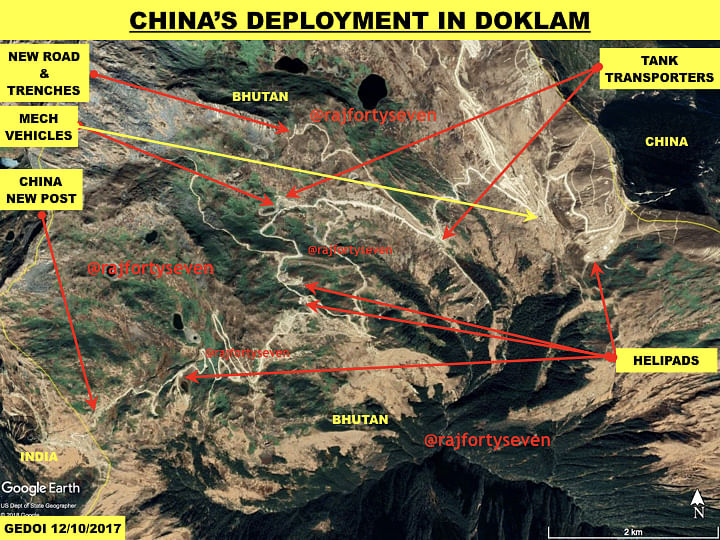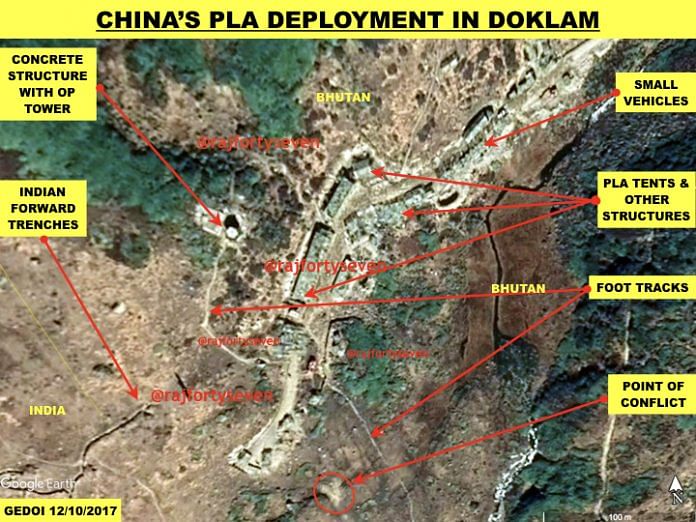New visuals show PLA deployment is close to last year’s face-off point and hasn’t thinned down as Indian Army chief Gen. Rawat claimed last week.
New Delhi: Almost five months after India and China agreed to end their tense military face-off in the Himalayan region of Doklam, Beijing has almost completely taken control of the northern side of the disputed plateau, latest satellite images accessed by ThePrint show.
The new images show concrete posts, seven helipads, new trenches and several dozen armoured vehicles close to the point where the Indian Army and the People’s Liberation Army (PLA) troops were locked in a 72-day confrontation last year.
The discovery comes days after Army chief General Bipin Rawat said that China continues to have troops in North Doklam but also added that the deployment had thinned down recently.
However, new satellite imagery accessed by ThePrint from 10 December 2017 shows that the Chinese side is now well entrenched in the area, with heavy road building machinery still present close to the stand-off point.
The face-off was triggered last June after Indian troops prevented Chinese workers backed by the PLA from completing a road that would have given them fast access to the south Doklam area. The Doklam plateau is contested between China and Bhutan, with India also having a strategic interest in keeping the area demilitarised.
These are first images that show the extent of the Chinese deployment at Doklam – and indicate a likely permanent PLA deployment, retaining the capability to construct the contested road at short notice.
Troop strength
The PLA has occupied almost every nook and corner, if not every inch, of the northern side of the plateau. Google Earth imagery clearly shows a large number of troops and equipment in semi-permanent structures under camouflage.
There is at least one complete mechanised regiment of possibly ZBL-09 IFVs or infantry fighting vehicles. There is also a strong possibility of another mechanised regiment under camouflage nets.

Two major parking areas have been observed for tank transporters of smaller size, suggesting their use for mechanised vehicle transport. There are, in total, two regiments’ worth of tank transporters on the Doklam plateau.
There are more than a hundred large troop/equipment-carrying vehicles, or what the military calls ‘B-vehicles’.
At least four large bulldozers and four tippers have also been observed. This indicates a clear intention of pursuing the construction of the road beyond the contested point.
A large number of troops seem to have been kept in tents under very good camouflage, but certainly not good enough for satellite imagery not to spot them.
The observation tower
There is a very tall observation tower, at least two storeys high, constructed with cement concrete less than 10 metres from the most forward trench occupied by the Indian Army.

The elevation profile of this tower suggests that it can observe the entire Gnathang Valley from Kupup to Zuluk. The entire movement of the Indian Army beyond Kupup can also be very clearly observed by the PLA.
New posts
A large number of fighting posts have been created on almost every hillock on North Doklam plateau. These posts consist of double-layered communication trenches prepared for all round defence.
Numerous areas have been dug out, possibly to accommodate troops under camouflage at a later date. One of the dug-out areas is quite large, suggesting that the PLA will construct an extremely tall observation tower very soon.
Helipads
At least seven new helipads have been constructed with permanent cemented round bases. The diameter of the helipads is 25 metres, suggesting that the largest helicopters in the PLA inventory will be able to land here.

Road construction
New roads have been constructed to cover the North Doklam plateau. Work is in progress to widen existing roads. Most of the roads have communication trenches running along them.
Colonel Vinayak Bhat (retd) is a Military Intelligence veteran of the Indian Army with vast experience of satellite imagery analysis. He has worked as a Chinese interpreter and is a specialist on PLA and Pakistan’s armed forces. He tweets @rajfortyseven







India Kolkata However, new satellite imagery accessed by ThePrint from 10 December 2017 shows that the Chinese side is now well entrenched in the area, with heavy road-building machinery still present close to the stand-off point.
The Indian Army did much worse in Siachin when it occupied Pakistani territory.
We should build up our army centre and create our arms buildup. If we consider chinese and paki there steps need to be confronted with aggression . Do not worry about war or even atomic or chemical or biological, you cannot live in peace when your neighbour is restless. So we should exercise our expansion in that region in same or duble length what neighbour displays.
What we need urgently is a short term, medium term and a long term policy that is clear and precise targeting both Pakistan and China.
China should immediately entice India to an extensive arms race to bankrupt India just like what Americans did to USSR. India GDP is 1/5 of China and Foreign Reserves is 1/8 of China.
China has indigenous arms industry and capabilities which can build arms at 1/ 2 of the cost of India’s expensive foreign purchases.
China also can maintain its own fleet as compared to India’s huge after sale maintenance bill.
chinese food anyone?
India doesn’t wants learn from 1962 war.Even now India is neither serious nor capable to match China,s might. Over & above our whole govt,s machinery is completely forgot with corruption. The situation is almost same when East India company came to India, our own people helped Britishers to control whole of Indian states. Indian freedom cycle is almost going to be over, now indian corrupt Politicians started to invite the foreign countries to invade India. Our IAS & IPS govt machinery has failed the Nation.There is no patriotism in our DNA. Hence be prepared to be ruled by foreign powers.
Seriously? you really believe that? check out the standoff in 1968 then on two separate occasions and then judge.
This entire para abt OP is so amateur. “There is a very tall observation tower, at least two storeys high (two storeys are very high? I thought min. of 50ft would qualify for High!), constructed with cement concrete less than 10 metres from the most forward trench occupied by the Indian Army. The elevation profile of this tower suggests that it can observe the entire Gnathang Valley from Kupup to Zuluk. The entire movement of the Indian Army beyond Kupup can also be very clearly observed by the PLA.”..
Col sir you know MI can do much better than that. The OP has a high mountain slope on its West gradually going down on its East. Looking into india, they can see north face of nathang ridge at a maximum which too is purely because of this geographical set up. to claim views of kurup and beyond, is too hypothetical.
The Cold War in Asia:
The spread of Communism to mainland China in 1949 initiated ‘The Cold War in Asia’. India was alarmed during 1948-49 when Communist Leader Mao Zedong openly disclosed his Expansionist doctrine. Tibet Equilibrium is the key to hold Balance of Power in Asia. Tibet is the third largest country in Asia following China, and India in terms of size. American fantasy of befriending Communist China to balance power in Europe has become our nightmare.
Image of PLA occupied area now n also two three year back,shown simultaneously clears the real picture.Also It’s not only PLA’s deployment but also Indian deployment at the area will show the real picture n also then only the news can be considered complete /unbiased news…
You can’t expect anything else from the vile and cunning Chinese especially when they have money and muscle both in abundance.
Surprised to see there is no snow even at the peak of winter! Chinese Dragon will continue to nibble away Indian territory slowly. Aksai Chin was lost in late ’50s. Difference now is we have surveillance and know immediately. Then we came to know much again the road was completed and large area annexed.
Bombast and 56Inch chest is not enough..cmon India..cone out of your bunker and face the dragon
THE PRICE OF PEACE IS ETERNAL VIGILANCE! ! LONG LIVE INDIA! !
Resisting China’s expansion is a responsibility of every democratic state.
Allied countries, like US, Japan, Australia, India and other smaller states that are becoming prey of China must help each other and coordinate their efforts militarily, politically and economicaly.
The Chinese r relentless especially when they perceive weakness in others. The Indians, to a certain extent, at least, tries to run away from reality: the pious hope harbored by some that, come winter, the Chinese would withdraw, bears this out.A firm resolve and a stout spine must be displayed now.
didn’t you realized that just an excuse by India government for retreat from being defeating? what firm resolve do you expect they can diplay?? LOL. if they can now, they won’t retreat at first place!!